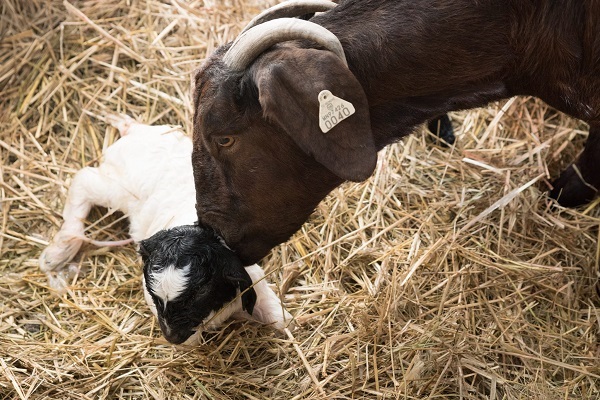

Goats are more aggressive than sheep. Whereas sheep tend to be fearful and shy and flee from attackers, goats are more exploratory and reactive and tend to face their attackers when threatened. Fighting behavior of sheep and goats is closely related to their horn structure and horn size is an indicator of social rank.
Goats show a high level of social organization, which allows better protection from predators, more effective foraging, better access to sexual partners and successful care and protection of offspring.
Goats are social creatures normally found in groups and it is recommended that they are not kept in isolation, at least for any length of time. Once formed, the group social structure can last for years. A clear, stable, linear hierarchy exists within groups and the most hierarchical position tends to be the most aggressive. When forage is available, there are differences in the diet between dominant and subordinate animals that disappear during shortages of forage.
Dominance within the group is in part dictated by age and body and horn size. Interestingly, those in the middle range of hierarchy tend to be the most productive.
In their natural environment goats are rarely found alone and forced isolation can be stressful. Forced isolation of pregnant females, especially during transport, can have lasting behavioral effects on their offspring. If females have to be isolated before they give birth, it is better to create small groups of other pregnant females or to isolate them but to allow the opportunity to smell, see and hear others from the same group.
Smell, sight and sound are important signals to bucks in detecting in-heat females. Olfactory (smell) signals are more important in goat flocks than they are in sheep, especially those relating to sexual and maternal behavior. Introducing males into a flock of seasonally anoestrus females causes a phenomenon known as “the buck effect” (the “male effect” also exists among sheep) which results in secretion of luteinising hormone in the females and synchronized ovulation
Goats urinate frequently and this is one of the main signals of individual identity and goats, especially in relation to reproductive status. They also secrete smell signals via pedal glands and a tail gland.
Male goats perform flehmen behavior in the presence of females as a response to receiving non-volatile smells (pheromones). This is a response seen in a number of animals that involves exposure of the front teeth by curling back the upper lip and closing the nostril. This facilitates the passage of non-volatile materials (pheromones) from the oral cavity to the vomeronasal (Jacobson’s) organ, which then prompts natural reproductive behavior.
Goats adopt a range of noises for various purposes, including bleating, snorting and sneezing. As well as smell recognition, does develop sight and sound recognition of their new-born kid within 4 hours of giving birth. There is sufficient difference between the bleating sound of individual kids to enable dams to recognize offspring based solely on sound.. Kids also use distress calls and isolation bleats to alert their mother of their whereabouts. The sounds that kids make vary with age, sex and body size and can be used to provide information about the physiological status of the animal.
Smell is also an important route through which adults and their young develop a bond. Mothers actively lick their young immediately after birth and very quickly establish a bond through smell recognition. The strength of this maternal recognition can be negatively affected if the doe is underfed during the second half of pregnancy. Although kids tend to hide during the first week of life, whereas lambs follow their mothers very soon after they are born, the mechanisms that control the onset of maternal behavior and bonding appear to be the same in both species.
Awareness of the importance of smell during the early hours is key as disruption of this stimulus can cause rejection.
 Contact Jaguza Support
Contact Jaguza Support